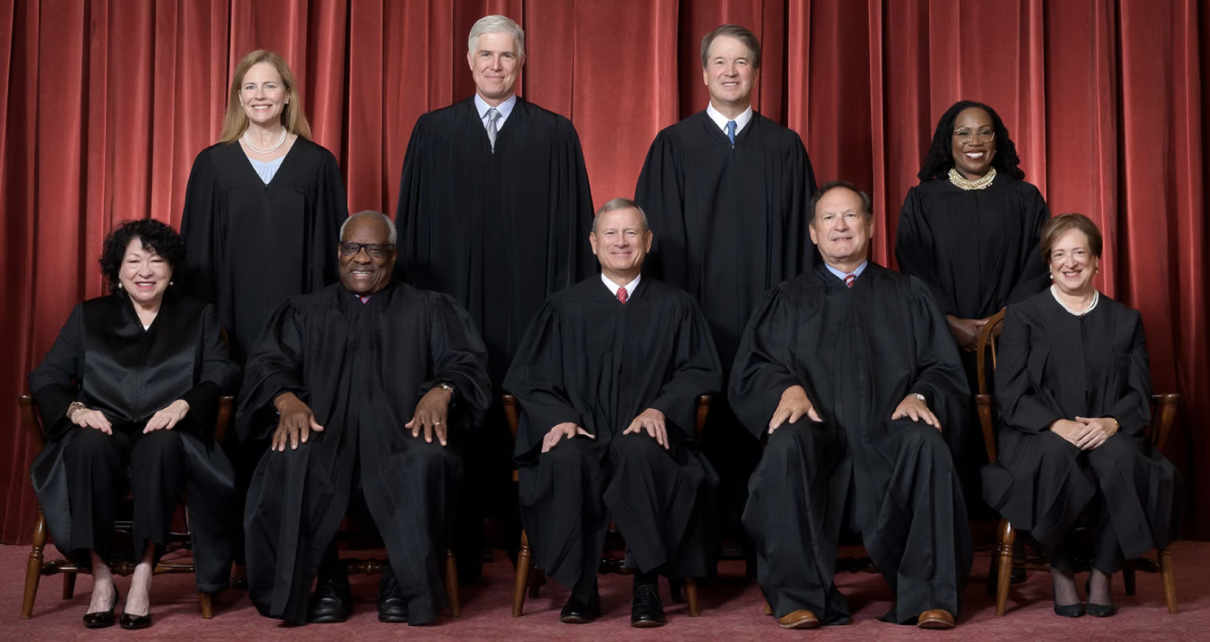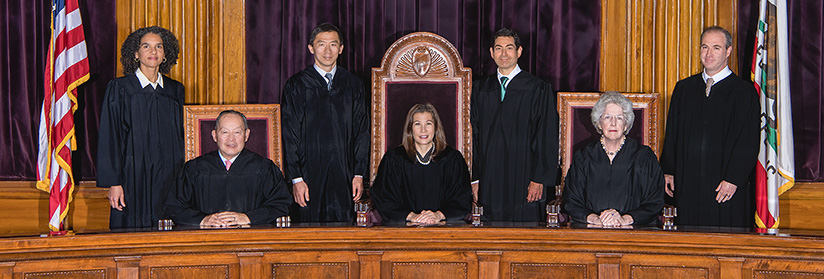
Justices of The U.S. Supreme Court. (Photo: supreme court.gov)
U.S. Supreme Court on a Hot Streak
String of SCOTUS decisions bolster the Constitution, rile Liberals
By Martin Marks, July 4, 2023 6:24 am
Trigger Alert: For those of you who feel that the American judicial system—the U.S. Supreme Court in particular, is there to reflect prevailing public sentiment, create law to support your world view, and/or take your feelings into account, this essay is not for you. I suggest you slink back to your “safe space” before reading any further.
It is said that elections have consequences, and no truer political observation has ever been made. It is also said that being in the right place at the right time can be crucial to any success story. Both sayings aptly apply to our 45th president and his administration.
The Election of 2016 brought with it the Presidency of Donald J. Trump. It also brought with it soon thereafter the departure of three Justices to the U.S. Supreme Court.
Soon after assuming office, Trump nominated Neil Gorsuch on Jan. 31, 2017, to replace Antonin Scalia who had died several months earlier.
On July 9, 2018, Trump appointed Bret Kavanaugh to replace Anthony Kennedy who had just retired.
Finally, on September 26, 2020 Amy Coney Barrett was appointed to replace the recently deceased Ruth Bader Ginsburg.
All three justices were confirmed by the U.S. Senate. It tweren’t purdy—in fact, the confirmation process was quite ugly in the case of Justice Kavanaugh as the Left saw its multi-decade grip on the Supreme Court ebbing away.
With the seating of this final appointment by Trump, the balance of the court now arguably tilted toward the conservatives by a 6-3 margin. One could posit that any GOP president would have nominated exactly the same jurists or certainly ones with similar judicial temperaments and perspectives. That is certainly debatable, yet not germane to the premise of this essay.
The table had been set, and conservatives around the nation were chomping at the bit to find the right cases to wind their way through our judicial system so that the new U.S. Supreme Court could rectify issues–and yes, precedents that had been set by Liberal courts over the last several decades. The granddaddy (please excuse that patriarchal expression) of them all came last year as the decision in the Dobbs v. Jackson Women’s Health Organization was first infamously leaked and then ultimately published on June 24 of last year. The Dobbs case essentially overturned the 1973 Roe v Wade decision which granted women a federal right to an abortion anywhere in the country and instead remanded the issue back to the various state legislatures across the land to craft their own laws on the matter. Of course, the Left was and continues to be apoplectic on the matter. Democrats used the issue to great success in the midterm election of 2022 as I wrote for the California Globe recently. And expect that issue to be the main thrust for the Democrats in the 2024 presidential election year looming on the horizon.
Regardless of the politics and public opinion on the abortion matter, the Roberts Court of 2022 got the matter exactly right constitutionally in the Dobbs case. The Supreme Court in 1973 effectively created a constitutional right and resulting law out of thin air when Roe was decided. The courts are no place to establish policy, as I wrote for the Globe last year. Even Liberal icon Associate Supreme Court Justice Ruth Bader Ginsburg had serious doubts on the validity of Roe.
In the final days of the Supreme Court term last week and approximating the one-year anniversary of the Dobbs decision, the Supremes rendered a flurry of case rulings that were not only much anticipated, but also thrilled conservative constitutionalists while at the same time crushed the hopes and dreams of Liberals in the Democrat party and their long-time cheering section in the mainstream media.
First, decisions were published in two cases that were heard together, Students for Fair Admissions v. President & Fellows of Harvard College and Students for Fair Admissions v. University of North Carolina, that would revisit the controversial practice of using racial preferences as criterion for admissions to college campuses. Citing the Equal Protection Clause of the 14th Amendment, the court ruled that the use of so-called Affirmative Action used to foster admission of one racial group would essentially deny admission to another racial group and therefore discriminate on the basis of race—a rather crystal clear constitutional violation.
While conservatives applauded, the Left lost their collective minds, and groused on many levels including that minority groups heretofore advanced by racial preferences simply do not have what it takes to compete and advance on their own merit. Racism indeed.
Within hours the next decision was handed down. In Creative LLC v Elenis the Court held that The First Amendment prohibits Colorado from forcing a website designer to create expressive designs with which the designer disagrees. In this case, it was a web designer who refused to develop a website for a gay marriage. The case paralleled the noted Masterpiece Cakeshop v Colorado Civil Rights Commission of 2018 where the Court held that the State Civil Rights Commission violated the cakeshop owner’s rights when they refused to prepare a cake for a gay wedding. The latest case took matters further and stated that First Amendment Rights to free expression protected the website owner’s right to refuse the design of the web site.
The Left’s—LGBTQ rights advocates in particular—reaction was predictable. This was cataclysmic and somehow portended a right for a proprietor of an establishment to deny service to any protected group for any reason. Nonsense.
The key words in the decision are “expressive designs”—a rather narrow term that protects an individual from creating a product that they find objectionable for religious or other personal reasons. Can a web designer or bakery turn away a customer at the door simply because they or gay, or black, or Latino, or Jewish, or Muslim, or disabled, etc.? Of course not. But to listen to some on the Left, this decision protecting religious rights guaranteed under the Constitution is the second coming of Jim Crow laws.
Finally, in Biden v. Nebraska and Department of Education v. Brown, the court struck down an attempt by the Biden Administration to wipe out up to $20,000 in student loan debt for millions who took out loans for education. In May of 2022, I wrote on the folly of this proposal as it was inherently unfair for those that diligently paid back their student loans and the moral hazard it created for those borrowing money with little intention of paying it back. Ultimately, this was yet another attempt by an administration to throw around “free money” in an attempt to curry favor with a particular demographic voting bloc.
As the Supreme Court saw it, the Biden administration had overstepped its constitutional boundaries. The majority decision held that it is Congress who has the authority to initiate such a loan forgiveness program and cannot be unilaterally enacted by fiat from the Executive branch. For the majority, Chief Justice John Roberts wrote:
“The question here is not whether something should be done; it is who has the authority to do it.”
The dissent from the Court’s three liberal justices claimed the majority was just making political decisions, which is ludicrous on its face and falls into the esoteric legal precept of “it takes one to know one.”
The protestations and corresponding meltdowns continue from the Left with one recurring theme: The United States Supreme Court is “out of step” with American public opinion.
Well, first of all, No. With the notable exception of the Dobbs case from last year, the Supreme Court Decisions referenced herein are not out of step with public opinion. As I pointed out in my essay a few weeks back, while the Dobbs decision overturning Roe v. Wade was constitutionally well-reasoned, the fact remains that the American public generally favors abortion being legally available to women by a fairly convincing margin. Democrats know they have a winner here and are likely to continue to politically bludgeon their Republican opponents with the issue in campaigns to come.
However, let’s take a look at the other three landmark decisions handed down recently.
In the decisions that derailed using race as a factor in university admissions, the American supports this overwhelmingly. A Pew Research poll showed that 74% of American favor eliminating race and ethnicity as criteria for university admissions. This stance is generally held for both Democrats and Republicans and across the spectrum of races. And if you don’t trust polls or the way questions within are posed, at least trust the American voter. Nine states have banned so-called Affirmative Action, including California. California, by virtue of Proposition 209, and five other states have done so through voter referendum, and based upon the Pew Research poll, it is likely that voters from other states would act similarly if given the chance.
Pew Research also showed that 60% of Americans believe business owners should not have to provide services if it might signal support for beliefs on LGBT issues that they oppose, while 38% believe those business owners should be required to do so.
While a majority of the general public, and certainly those students and their families who presently owe on their loans, favor some type of loan forgiveness, the Cato Institute conducted a more nuanced poll that asked those being queried if their opinions would change after considering the costs of a loan forgiveness program. The answer was a resounding yes. Nearly two‐thirds of Americans oppose cancellation if forgiving $10,000 per borrower raises their taxes (64%) or if it primarily benefits higher income people (68%). Even more Americans oppose if cancellation incentivizes colleges and universities to further raise prices, as research has shown it may. About three‐fourths of Americans would oppose student debt cancellation if it caused universities to raise their tuition and fees (76%) or if it caused more employers to require college degrees, even if not needed to do the job (71%).
More importantly, the U.S. Supreme Court and our judicial system in general should not be governed or even influenced by public opinion in the first place. Those wearing the black robes are meant to be insulated from public opinion and the only fealty they owe is to the U.S. Constitution or to the various state constitutions in the case of state jurists. Chief Justice John Roberts alluded to this as he backhanded the three liberal dissenting justices in the Affirmative Action cases. Roberts wrote:
“….the dissenting justices offer a remarkably wrong view of the judiciary.”
So, where do we go from here, and what can we expect from the Roberts Court in the future?
Perhaps it is best to take a look at the justices that make up the now 6-member bloc that has decided these recent cases.
The longest tenured Associate Justice Clarence Thomas was appointed to the court in 1991 and just celebrated his 75th birthday. Who knows how much longer he might serve?
However, the remaining five members of that conservative bloc are:
John Roberts, 68.
Samuel Alito, 73.
Neal Gorsuch, 55.
Brett Kavanaugh, 57.
Amy Coney Barrett, 51.
Unless the Biden Administration attempts to do something dramatic if not desperate such as imposing term limits on the court or packing it with more than the present 9-member contingent, the conservative bloc of Justices will hold a majority for years if not decades to come. We can expect that future decisions from the U.S. Supreme Court will continue to be made using strict and originalist interpretation of the U.S. Constitution irrespective of public opinion and much to the chagrin of the Left who views the role of the courts as something other than originally intended.
- Is DEI Ready To DIE? - January 4, 2025
- Just How Effective Was The Abortion Debate in The 2024 Election? - November 18, 2024
- Federal District Court Holds UCLA Accountable for Campus Antisemitism - August 20, 2024




The Constitution says government will be neutral on religion, but the Supremes found a way around that in the First Amendment. Clever. But it locks them into supporting social media rules against hate speech and disinformation, doesn’t it? Be careful what you wish for?